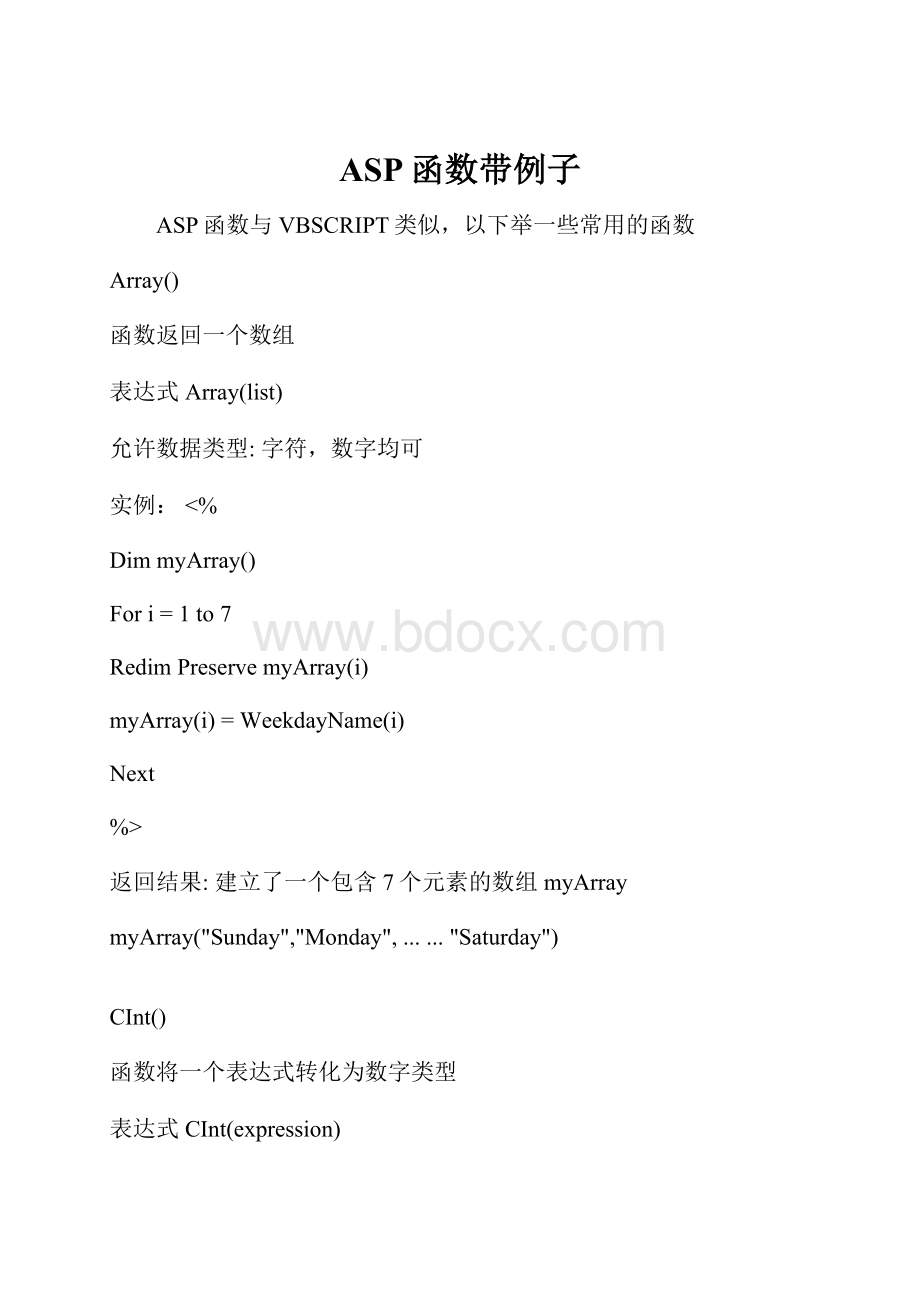ASP函数带例子.docx
《ASP函数带例子.docx》由会员分享,可在线阅读,更多相关《ASP函数带例子.docx(22页珍藏版)》请在冰豆网上搜索。

ASP函数带例子
ASP函数与VBSCRIPT类似,以下举一些常用的函数
Array()
函数返回一个数组
表达式Array(list)
允许数据类型:
字符,数字均可
实例:
<%
DimmyArray()
Fori=1to7
RedimPreservemyArray(i)
myArray(i)=WeekdayName(i)
Next
%>
返回结果:
建立了一个包含7个元素的数组myArray
myArray("Sunday","Monday",......"Saturday")
CInt()
函数将一个表达式转化为数字类型
表达式CInt(expression)
允许数据类型:
任何有效的字符均可
实例:
<%
f="234"
response.writecINT(f)+2
%>
返回结果:
236
转化字符"234"为数字"234",如果字符串为空,则返回0值
CreateObject()
函数建立和返回一个已注册的ACTIVEX组件的实例。
表达式CreateObject(objName)
允许数据类型:
objName是任何一个有效、已注册的ACTIVEX组件的名字.
实例:
<%
Setcon=Server.CreateObject("ADODB.Connection")
%>
CStr()
函数转化一个表达式为字符串.
表达式CStr(expression)
允许数据类型:
expression是任何有效的表达式。
实例:
<%
s=3+2
response.write"The返回结果is:
"&cStr(s)
%>
返回结果:
转化数字“5”为字符“5”。
Date()
函数返回当前系统日期.
表达式Date()
允许数据类型:
None.
实例:
<%=Date%>
返回结果:
9/9/00
DateAdd()
函数返回一个被改变了的日期。
表达式DateAdd(timeinterval,number,date)
允许数据类型:
timeintervalisthetimeintervaltoadd;
numberisamountoftimeintervalstoadd;
anddateisthestartingdate.
实例:
<%
currentDate=#9/9/00#
newDate=DateAdd("m",3,currentDate)
response.writenewDate
%>
<%
currentDate=#12:
34:
45PM#
newDate=DateAdd("h",3,currentDate)
response.writenewDate
%>
返回结果:
9/9/00
3:
34:
45PM
"m"="month";
"d"="day";
IfcurrentDateisintimeformatthen,
"h"="hour";
"s"="second";
DateDiff()
函数返回两个日期之间的差值。
表达式DateDiff(timeinterval,date1,date2[,firstdayofweek[,firstweekofyear]])
允许数据类型:
timeinterval表示相隔时间的类型,如“M“表示“月”。
实例:
<%
fromDate=#9/9/00#
toDate=#1/1/2000#
response.write"Thereare"&_
DateDiff("d",fromDate,toDate)&_
"daystomilleniumfrom9/9/00."
%>
返回结果:
从9/9/00到2000年还有150天.
Day()
函数返回一个月的第几日.
表达式Day(date)
允许数据类型:
date是任何有效的日期。
实例:
<%=Day(#9/9/00#)%>
返回结果:
4
FormatCurrency()
函数返回表达式,此表达式已被格式化为货币值
表达式FormatCurrency(Expression[,Digit[,LeadingDigit[,Paren[,GroupDigit]]]])
允许数据类型:
Digit指示小数点右侧显示位数的数值。
默认值为-1,指示使用的是计算机的区域设置;LeadingDigit三态常数,指示是否显示小数值小数点前面的零。
ASP函数与VBSCRIPT类似,以下举一些常用的函数
Array()
函数返回一个数组
表达式Array(list)
允许数据类型:
字符,数字均可
实例:
<%
DimmyArray()
Fori=1to7
RedimPreservemyArray(i)
myArray(i)=WeekdayName(i)
Next
%>
返回结果:
建立了一个包含7个元素的数组myArray
myArray("Sunday","Monday",......"Saturday")
CInt()
函数将一个表达式转化为数字类型
表达式CInt(expression)
允许数据类型:
任何有效的字符均可
实例:
<%
f="234"
response.writecINT(f)+2
%>
返回结果:
236
转化字符"234"为数字"234",如果字符串为空,则返回0值
CreateObject()
函数建立和返回一个已注册的ACTIVEX组件的实例。
表达式CreateObject(objName)
允许数据类型:
objName是任何一个有效、已注册的ACTIVEX组件的名字.
实例:
<%
Setcon=Server.CreateObject("ADODB.Connection")
%>
CStr()
函数转化一个表达式为字符串.
表达式CStr(expression)
允许数据类型:
expression是任何有效的表达式。
实例:
<%
s=3+2
response.write"The返回结果is:
"&cStr(s)
%>
返回结果:
转化数字“5”为字符“5”。
Date()
函数返回当前系统日期.
表达式Date()
允许数据类型:
None.
实例:
<%=Date%>
返回结果:
9/9/00
DateAdd()
函数返回一个被改变了的日期。
表达式DateAdd(timeinterval,number,date)
允许数据类型:
timeintervalisthetimeintervaltoadd;
numberisamountoftimeintervalstoadd;
anddateisthestartingdate.
实例:
<%
currentDate=#9/9/00#
newDate=DateAdd("m",3,currentDate)
response.writenewDate
%>
<%
currentDate=#12:
34:
45PM#
newDate=DateAdd("h",3,currentDate)
response.writenewDate
%>
返回结果:
9/9/00
3:
34:
45PM
"m"="month";
"d"="day";
IfcurrentDateisintimeformatthen,
"h"="hour";
"s"="second";
DateDiff()
函数返回两个日期之间的差值。
表达式DateDiff(timeinterval,date1,date2[,firstdayofweek[,firstweekofyear]])
允许数据类型:
timeinterval表示相隔时间的类型,如“M“表示“月”。
实例:
<%
fromDate=#9/9/00#
toDate=#1/1/2000#
response.write"Thereare"&_
DateDiff("d",fromDate,toDate)&_
"daystomilleniumfrom9/9/00."
%>
返回结果:
从9/9/00到2000年还有150天.
Day()
函数返回一个月的第几日.
表达式Day(date)
允许数据类型:
date是任何有效的日期。
实例:
<%=Day(#9/9/00#)%>
返回结果:
4
FormatCurrency()
函数返回表达式,此表达式已被格式化为货币值
表达式FormatCurrency(Expression[,Digit[,LeadingDigit[,Paren[,GroupDigit]]]])
允许数据类型:
Digit指示小数点右侧显示位数的数值。
默认值为-1,指示使用的是计算机的区域设置;LeadingDigit三态常数,指示是否显示小数值小数点前面的零。
返回结果:
False
IsNumeric()
函数判断一对象是否为数字,返回布尔值.
表达式IsNumeric(expression)
实例:
<%
i="345"
response.writeIsNumeric(i)
%>
返回结果:
True
就算数字加了引号,ASP还是认为它是数字。
IsObject()
函数判断一对象是否为对象,返回布尔值.
表达式IsObject(expression)
实例:
<%
Setcon=Server.CreateObject("ADODB.Connection")
response.writeIsObject(con)
%>
返回结果:
True
LBound()
函数返回指定数组维的最小可用下标.
表达式Lbound(arrayname[,dimension])
实例:
<%
i=Array("Monday","Tuesday","Wednesday")
response.writeLBound(i)
%>
返回结果:
0
LCase()
函数返回字符串的小写形式
表达式Lcase(string)
实例:
<%
strTest="Thisisatest!
"
response.writeLCase(strTest)
%>
返回结果:
thisisatest!
Left()
函数返回字符串左边第length个字符以前的字符(含第length个字符).
表达式Left(string,length)
实例:
<%
strTest="Thisisatest!
"
response.writeLeft(strTest,3)
%>
返回结果:
Thi
Len()
函数返回字符串的长度.
表达式Len(string|varName)
实例:
<%
strTest="Thisisatest!
"
response.writeLen(strTest)
%>
返回结果:
15
LTrim()
函数去掉字符串左边的空格.
表达式LTrim(string)
实例:
<%
strTest="Thisisatest!
"
response.writeLTrim(strTest)
%>
返回结果:
Thisisatest!
Mid()
函数返回特定长度的字符串(从start开始,长度为length).
表达式Mid(string,start[,length])
实例:
<%
strTest="Thisisatest!
TodayisMonday."
response.writeMid(strTest,17,5)
%>
返回结果:
Today
Minute()
函数返回时间的分钟.
表达式Minute(time)
实例:
<%=Minute(#12:
45:
32PM#)%>
返回结果:
45
Month()
函数返回日期.
表达式Month(date)
实例:
<%=Month(#08/04/99#)%>
返回结果:
8
MonthName()
函数返回指定月份
表达式MonthName(month,[,Abb])
实例:
<%=MonthName(Month(#08/04/99#))%>
返回结果:
August
Now()
函数返回系统时间
表达式Now()
实例:
<%=Now%>
返回结果:
9/9/009:
30:
16AM
Right()
函数返回字符串右边第length个字符以前的字符(含第length个字符).
表达式Right(string,length)
实例:
<%
strTest="Thisisantest!
"
response.writeRight(strTest,3)
%>
返回结果:
st!
Rnd()
函数产生一个随机数.
表达式Rnd[(number)]
实例:
<%
Randomize()
Rnd()
函数产生一个随机数.
表达式Rnd[(number)]
实例:
<%
Randomize()
response.writeRND()
%>
返回结果:
任何一个在0到1之间的数
Round()
函数返回按指定位数进行四舍五入的数值.
表达式Round(expression[,numRight])
实例:
<%
i=32.45678
response.writeRound(i)
%>
返回结果:
32
Rtrim()
函数去掉字符串右边的字符串.
表达式Rtrim(string)
实例:
<%
strTest="Thisisatest!
!
"
response.writeRTrim(strTest)
%>
返回结果:
Thisisatest!
!
Split()
函数将一个字符串分割并返回分割结果
表达式Split(S[,d])
实例:
<%V=Split(A,B,C)
Fori=0ToUBound(V)
Response.WriteV(i)
Next
%>
返回结果:
ABC
Second()
函数返回秒.
表达式Second(time)
实例:
<%=Second(#12:
34:
28PM#)%>
返回结果:
28
StrReverse()
函数反排一字符串
表达式StrReverse(string)
实例:
<%
strTest="Thisisatest!
!
"
response.writeStrReverse(strTest)
%>
返回结果:
!
!
tsetasisihT
Time()
函数返回系统时间.
表达式Time()
实例:
<%=Time%>
返回结果:
9:
58:
28AM
Trim()
函数去掉字符串左右的空格.
表达式Trim(string)
实例:
<%
strTest="Thisisatest!
!
"
response.writeTrim(strTest)
%>
返回结果:
Thisisatest!
!
UBound()
函数返回指定数组维数的最大可用下标>.
表达式Ubound(arrayname[,dimension])
实例:
<%
i=Array("Monday","Tuesday","Wednesday")
response.writeUBound(i)
%>
返回结果:
2
UCase()
函数返回字符串的大写形式.
表达式UCase(string)
允许数据类型:
实例:
<%
strTest="Thisisatest!
!
"
response.writeUCase(strTest)
%>
返回结果:
THISISATEST!
!
VarType()
函数返回指示变量子类型的值
表达式VarType(varName)
实例:
<%
i=3
response.writevarType(i)
%>
返回结果:
2(数字)详见"asp常数"
WeekDay()
函数返回在一周的第几天.
表达式WeekDay(date[,firstdayofweek])
实例:
<%
d=#9/9/00#
response.writeWeekday(d)
%>
返回结果:
4(星期三)
WeekDayName()
函数返回一周第几天的名字.
表达式WeekDayName(weekday[,Abb[,firstdayofweek]])
实例:
<%
d=#9/9/00#
response.writeWeekdayName(Weekday(d))
%>
返回结果:
Wednesday
Year()
函数返回当前的年份.
表达式Year(date)
实例:
<%=Year(#9/9/00#)%>
返回结果:
1999